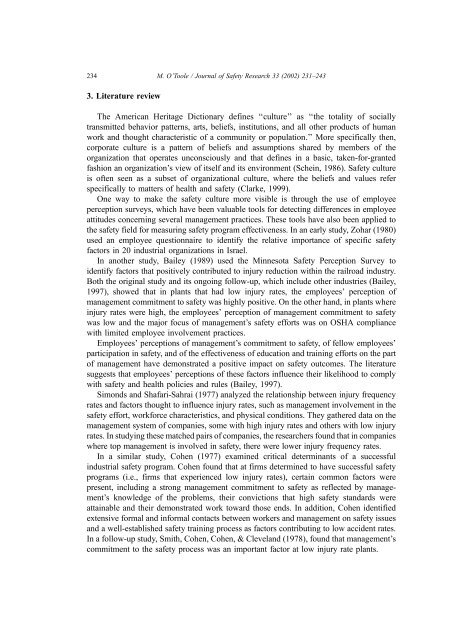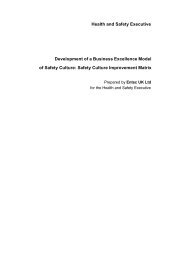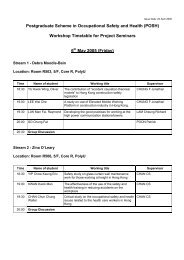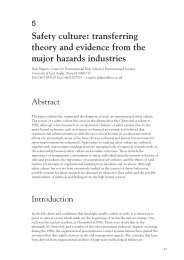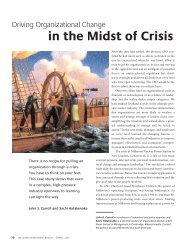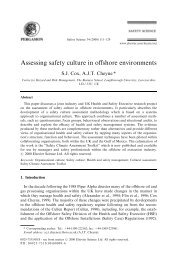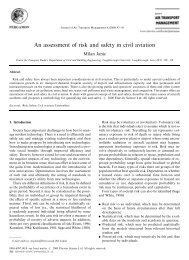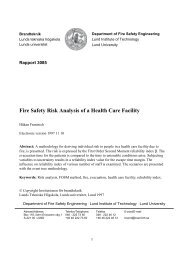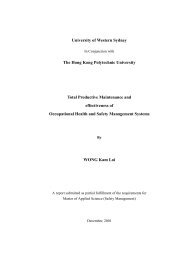The relationship between employees' perceptions of safety and ...
The relationship between employees' perceptions of safety and ...
The relationship between employees' perceptions of safety and ...
Create successful ePaper yourself
Turn your PDF publications into a flip-book with our unique Google optimized e-Paper software.
234<br />
M. O’Toole / Journal <strong>of</strong> Safety Research 33 (2002) 231–243<br />
3. Literature review<br />
<strong>The</strong> American Heritage Dictionary defines ‘‘culture’’ as ‘‘the totality <strong>of</strong> socially<br />
transmitted behavior patterns, arts, beliefs, institutions, <strong>and</strong> all other products <strong>of</strong> human<br />
work <strong>and</strong> thought characteristic <strong>of</strong> a community or population.’’ More specifically then,<br />
corporate culture is a pattern <strong>of</strong> beliefs <strong>and</strong> assumptions shared by members <strong>of</strong> the<br />
organization that operates unconsciously <strong>and</strong> that defines in a basic, taken-for-granted<br />
fashion an organization’s view <strong>of</strong> itself <strong>and</strong> its environment (Schein, 1986). Safety culture<br />
is <strong>of</strong>ten seen as a subset <strong>of</strong> organizational culture, where the beliefs <strong>and</strong> values refer<br />
specifically to matters <strong>of</strong> health <strong>and</strong> <strong>safety</strong> (Clarke, 1999).<br />
One way to make the <strong>safety</strong> culture more visible is through the use <strong>of</strong> employee<br />
perception surveys, which have been valuable tools for detecting differences in employee<br />
attitudes concerning several management practices. <strong>The</strong>se tools have also been applied to<br />
the <strong>safety</strong> field for measuring <strong>safety</strong> program effectiveness. In an early study, Zohar (1980)<br />
used an employee questionnaire to identify the relative importance <strong>of</strong> specific <strong>safety</strong><br />
factors in 20 industrial organizations in Israel.<br />
In another study, Bailey (1989) used the Minnesota Safety Perception Survey to<br />
identify factors that positively contributed to injury reduction within the railroad industry.<br />
Both the original study <strong>and</strong> its ongoing follow-up, which include other industries (Bailey,<br />
1997), showed that in plants that had low injury rates, the employees’ perception <strong>of</strong><br />
management commitment to <strong>safety</strong> was highly positive. On the other h<strong>and</strong>, in plants where<br />
injury rates were high, the employees’ perception <strong>of</strong> management commitment to <strong>safety</strong><br />
was low <strong>and</strong> the major focus <strong>of</strong> management’s <strong>safety</strong> efforts was on OSHA compliance<br />
with limited employee involvement practices.<br />
Employees’ <strong>perceptions</strong> <strong>of</strong> management’s commitment to <strong>safety</strong>, <strong>of</strong> fellow employees’<br />
participation in <strong>safety</strong>, <strong>and</strong> <strong>of</strong> the effectiveness <strong>of</strong> education <strong>and</strong> training efforts on the part<br />
<strong>of</strong> management have demonstrated a positive impact on <strong>safety</strong> outcomes. <strong>The</strong> literature<br />
suggests that employees’ <strong>perceptions</strong> <strong>of</strong> these factors influence their likelihood to comply<br />
with <strong>safety</strong> <strong>and</strong> health policies <strong>and</strong> rules (Bailey, 1997).<br />
Simonds <strong>and</strong> Shafari-Sahrai (1977) analyzed the <strong>relationship</strong> <strong>between</strong> injury frequency<br />
rates <strong>and</strong> factors thought to influence injury rates, such as management involvement in the<br />
<strong>safety</strong> effort, workforce characteristics, <strong>and</strong> physical conditions. <strong>The</strong>y gathered data on the<br />
management system <strong>of</strong> companies, some with high injury rates <strong>and</strong> others with low injury<br />
rates. In studying these matched pairs <strong>of</strong> companies, the researchers found that in companies<br />
where top management is involved in <strong>safety</strong>, there were lower injury frequency rates.<br />
In a similar study, Cohen (1977) examined critical determinants <strong>of</strong> a successful<br />
industrial <strong>safety</strong> program. Cohen found that at firms determined to have successful <strong>safety</strong><br />
programs (i.e., firms that experienced low injury rates), certain common factors were<br />
present, including a strong management commitment to <strong>safety</strong> as reflected by management’s<br />
knowledge <strong>of</strong> the problems, their convictions that high <strong>safety</strong> st<strong>and</strong>ards were<br />
attainable <strong>and</strong> their demonstrated work toward those ends. In addition, Cohen identified<br />
extensive formal <strong>and</strong> informal contacts <strong>between</strong> workers <strong>and</strong> management on <strong>safety</strong> issues<br />
<strong>and</strong> a well-established <strong>safety</strong> training process as factors contributing to low accident rates.<br />
In a follow-up study, Smith, Cohen, Cohen, & Clevel<strong>and</strong> (1978), found that management’s<br />
commitment to the <strong>safety</strong> process was an important factor at low injury rate plants.


